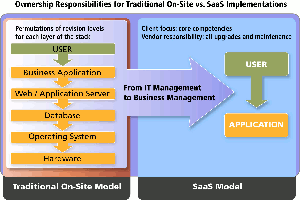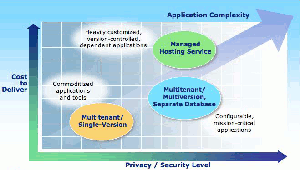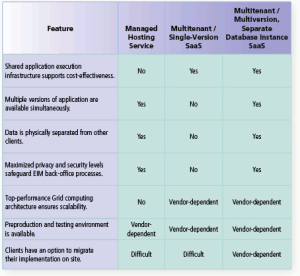
The demand for automated incentive compensation has brought it into the on-demand world. Implementing a world-class enterprise incentive management (EIM) system is essential given today’s fierce global competition, and as Software as a Service (SaaS) gains momentum, more and more companies look for EIM in a SaaS model.
The mission-critical, confidential nature of EIM differentiates it from other applications and requires specific SaaS capabilities. Organizations examining EIM applications with the goal of leveraging SaaS must evaluate prospective vendors on a number of counts.
Starting with a best-of-breed EIM application is most important, followed by a careful scrutiny of the vendor’s SaaS architecture model and other contracted provisions. The model should minimize privacy and security concerns, maintain or improve reliability, and ensure availability, scalability and performance — all while effectively containing costs and accommodating application complexity. The ideal architecture helps accomplish these objectives via physically separated client databases, a shared infrastructure and multiple application versioning.
SaaS Supporting EIM
As the numbers of SaaS deployments expand worldwide, many analysts forecast a strong upward trend in outsourced applications. By 2011, 25 percent of new business software will be delivered as SaaS, according to research firm Gartner.
Economic pressures, information technology (IT) prioritizing, fierce competition and a heightened emphasis on core competencies are making SaaS more and more attractive — and it is effective for an increasing number of business processes. The growing popularity of Web 2.0 collaboration and SaaS technology improvements make SaaS a sensible next step.
“Abhijit Dubey of McKinsey revealed that a new survey by his organization has found that the proportion of CIOs (chief information officers) considering adopting SaaS applications in the coming year has gone from 38 percent a year ago to 61 percent now. … It’s an indication of a sea-change in acceptance of SaaS over the past year,” stated software industry trend strategist Phil Wainewright.
SaaS suits EIM for three important reasons. EIM systems management is usually outside an organization’s core competencies. Business Week Online recently published a commentary on the myths of SaaS, indicating that “today’s economic and competitive pressures make nearly any form of outsourcing fair game. Many companies now consider various IT functions and business applications commodities and not core competencies. This has made SaaS, essentially an outsourced application management business, more attractive today than ASPs (application service provider) and hosting services of the past.”
EIM does not require on-site deployment because it operates effectively outside a corporation’s walls. SaaS efficiently manages well defined tasks and business processes that can be performed externally and integrated into the enterprise. EIM fits this category.
EIM’s purpose is positively impacting the bottom line, not escalating costs. “Software as a Service is starting to gain favor for several reasons: It’s relatively easy and inexpensive to implement; it’s flexible; it doesn’t require as much infrastructure; and its costs are more predictable,” according to Information Week.
It is dangerous to choose SaaS simply because of its popularity. Decision makers should first examine vendors with EIM functionality, focusing on applications rather than the delivery model.
Selecting the application prior to the delivery method prioritizes the solution to the business problem. If the chosen vendor offers SaaS, it is advisable to then evaluate the SaaS model in light of the remainder of this article.
The Ideal SaaS Architecture Model for EIM
EIM’s unique characteristics dictate specific SaaS capabilities. EIM is mission-critical, demanding maximum uptime. Availability and reliability are imperatives because unchecked errors and failures can spell disaster.
EIM is also a time-dependent, back-office system requiring high levels of application complexity. Privacy, security, functionality and robustness are critical but tend to decline with decreasing application complexity. Data integrity must be safeguarded, and organizations require control over upgrade timing.
The ideal model meets EIM’s requirements through a physical separation of data between clients, a shared application infrastructure and the availability of multiple application versions.
Physically Separated Databases
Physical separation of data between clients is essential for privacy, security, reliability and availability. For instance, with only logical data separation, a database-related programming error made by the vendor could replicate throughout all clients, affecting the entire system because client data is comingled.
Comingled data makes clients vulnerable to a single point of failure that impacts security and availability — with ripple effects on privacy and reliability. Forrester Research’s November 2005 Business Technographics survey asked firms, “How important are the following when considering adopting Software as a Service?” For respondents answering “Very Important,” the top four factors from organizations in North America were as follows:
- 71 percent mentioned application availability and reliability
- 45 percent mentioned fast deployment times
- 35 percent mentioned flexible consumption
- 32 percent mentioned simplified pricing models
The large numbers that valued availability and reliability suggest there should be no compromise on system availability — achievable through physical data separation — at the expense of faster deployments, consumption flexibility and pricing simplicity.
Involving Multiple Clients
In multitenant models, multiple clients leverage the same application infrastructure, which helps contain costs. For example, companies pay for and make use of processing power only when needed, instead of investing in infrastructure that is idle outside of peak periods.
The SaaS infrastructure should allow availability of more than one application version at a time. Clients receive individualized attention, and there is no unilateral control over versioning and upgrades. With a single-version model, upgrades could be pushed out during pipeline runs and other critical periods, putting an organization at a disadvantage.
Analysts have identified a number of infrastructure models currently in use for outsourced applications. This article examines three of these, which Gartner identifies using the terms managed hosting service; multitenant/single-version model; and multitenant/multiversion, separate database instance model.
As indicated in the following comparison of the three models, the multitenant/multiversion, separate database instance model offers the greatest likelihood of success with EIM.
Managed Hosting Service
Managed hosting service vendors employ a fully dedicated system in which hardware and software are assigned to a single client.
“A model where the infrastructure is dedicated, multiple software versions are allowed and the database instances are physically separated is a managed application-hosting service. Although not falling strictly under the SaaS definition (that is, shared code and data model in a one-to-many environment), any application can be hosted,” according to Gartner.
The client benefits from superior security and privacy protection, but as Gartner states, a managed hosting service “will have the highest theoretical costs because there is the least amount of cost sharing across users.”
A dedicated system is expensive to administrate, and operational fees and equipment amortization are passed on to the client. In addition, today’s managed hosting service EIM vendors do not leverage a Grid configuration for scalable processing power. EIM’s efficiency and cost-effectiveness improve with Grid in a multitenant infrastructure. With a managed hosting service, backups, redundancies, colocated hardware and third-party vendor management multiply costs.
Multitenant/Single-Version Model
A multitenant/single-version model infrastructure is shared by multiple clients, and only one version of the software is available at a given time. Each client’s database is logically — but not physically –separated from the others. Though economical to deliver, there are downfalls in a number of areas, including security, availability, flexibility, the capacity for complexity and scalability.
EIM’s sales and compensation data is extremely sensitive, and this model is vulnerable to security breaches and availability problems due to its single point of failure. Clients also have no control over upgrades. Gartner has indicated that “there is a potential increase in security risk because the data is not physically separated, and the application upgrade schedule is the vendor’s schedule, not the user’s.”v
This model is appropriate for less complex applications having fewer integration points. Lacking the scalability for optimized EIM, it is also less likely to incorporate customer-specific, robust features that enhance performance. Migrating to an in-house implementation is prohibitive.
Multitenant/Multiversion, Separate Database Instance Model
A multitenant/multiversion, separate database instance model provides the privacy and security benefits of a managed hosting service without the inherent costs and the economies of a multitenant/single-version model without the vulnerabilities.
Multiple clients share the application execution infrastructure, and more than one software version may be available at a time. The separate database instance results in physical separation of data among clients.
With a multitenant/multiversion, separate database instance model, “the data is physically separated and there is the potential for improved data privacy,” according to Gartner. This model “offers the advantages of multitenant/multiversion, such as version control, but with added perceived data security.”
With no single point of failure, data privacy, security and system availability are uncompromised.
In addition, Gartner mentions that, for the multitenant/multiversion model, “The upgrade process is more flexible because of the multiple-version support.”
Again, this statement can also be applied to the multitenant/multiversion, separate database instance model, where support for multiple software versions enables clients to upgrade at their convenience and not the vendor’s. Migration to an in-house implementation is also feasible.
Additional Selection Factors
“There are common key issues and questions you should address with your potential SaaS vendor before making a purchase decision, independent of which type of software functionality you are considering,” recommends Gartner.
When it comes to EIM delivered via SaaS, the following is a short list of evaluation criteria to examine:
- Performance and scalability: Grid computing provides tremendous processing power with virtually unlimited performance scalability, and costs are contained for multiple clients. (While Grid is optimal, Unix and Linux infrastructures also scale.)
- Preproduction and testing phases: Companies stage and test their systems prior to deployment.
- Migration: Converting a SaaS implementation to an on-site implementation is an option at each contract milestone.
- Configurability: The implementation accommodates customer-specific integration points and data feeds without expensive custom coding.
- Full functionality: Housed within an enterprise-hardened data center, the SaaS version provides the same features and benefits as the on-site version.
- Compliance: Built-in, automated tracking and reporting ensure compliance with the Sarbanes-Oxley Act of 2002 (SOX) and include certification for the Statement on Auditing Standards No. 70, Service Organizations (SAS 70).
- Flexibility: Specific enhancements are available but not mandatory.
Organizations should choose an EIM vendor that leverages SaaS technology proficiently; uses a scalable multitenant/multiversion, separate database instance model; and provides additional customer-centric features. The vendor accomplishing this while understanding clients’ needs and valuing their trust is the one to consider.
Jeffrey Saling is a vice president at Callidus Software, a provider of on-premise and on-demand sales performance management solutions. Customers/partners include 7-Eleven, Accenture, CUNA Mutual, HP, IBM, Philips Medical Systems, Sun Microsystems and Wachovia.















































Social CRM
See all Social CRM